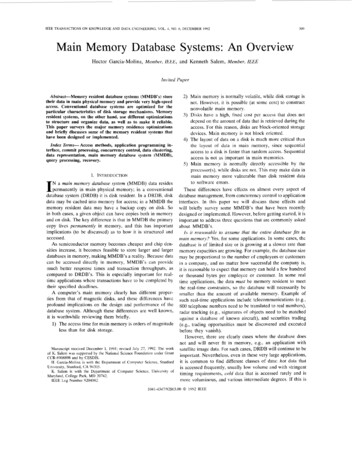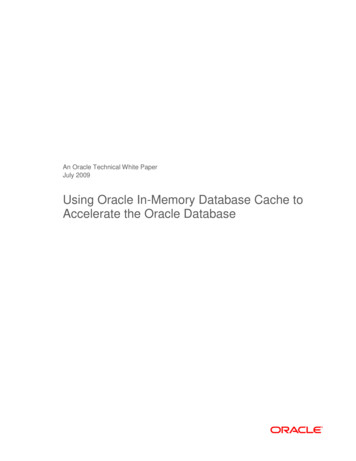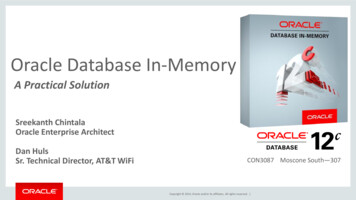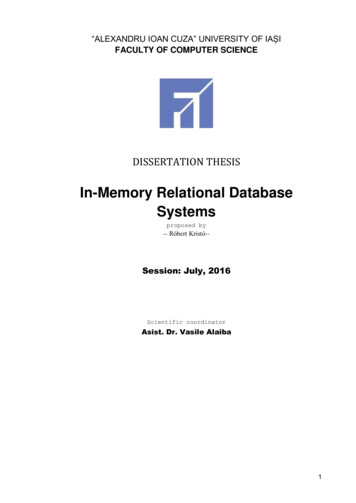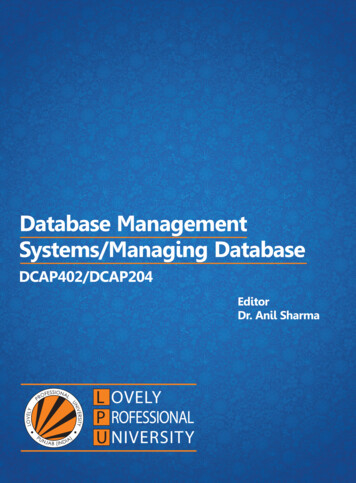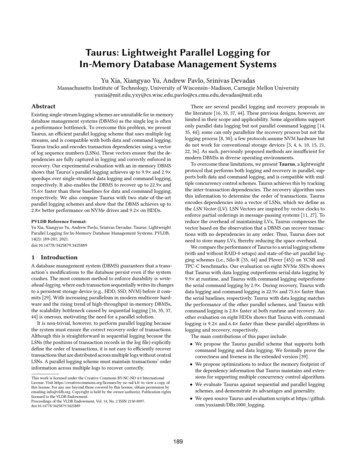
Transcription
Taurus: Lightweight Parallel Logging forIn-Memory Database Management SystemsYu Xia, Xiangyao Yu, Andrew Pavlo, Srinivas DevadasMassachusetts Institute of Technology, University of Wisconsin–Madison, Carnegie Mellon mu.edu,devadas@mit.eduAbstractExisting single-stream logging schemes are unsuitable for in-memorydatabase management systems (DBMSs) as the single log is oftena performance bottleneck. To overcome this problem, we presentTaurus, an efficient parallel logging scheme that uses multiple logstreams, and is compatible with both data and command logging.Taurus tracks and encodes transaction dependencies using a vectorof log sequence numbers (LSNs). These vectors ensure that the dependencies are fully captured in logging and correctly enforced inrecovery. Our experimental evaluation with an in-memory DBMSshows that Taurus’s parallel logging achieves up to 9.9 and 2.9 speedups over single-streamed data logging and command logging,respectively. It also enables the DBMS to recover up to 22.9 and75.6 faster than these baselines for data and command logging,respectively. We also compare Taurus with two state-of-the-artparallel logging schemes and show that the DBMS achieves up to2.8 better performance on NVMe drives and 9.2 on HDDs.PVLDB Reference Format:Yu Xia, Xiangyao Yu, Andrew Pavlo, Srinivas Devadas. Taurus: LightweightParallel Logging for In-Memory Database Management Systems. PVLDB,14(2): 189-201, 2021.doi:10.14778/3425879.34258891IntroductionA database management system (DBMS) guarantees that a transaction’s modifications to the database persist even if the systemcrashes. The most common method to enforce durability is writeahead-logging, where each transaction sequentially writes its changesto a persistent storage device (e.g., HDD, SSD, NVM) before it commits [29]. With increasing parallelism in modern multicore hardware and the rising trend of high-throughput in-memory DBMSs,the scalability bottleneck caused by sequential logging [16, 35, 37,44] is onerous, motivating the need for a parallel solution.It is non-trivial, however, to perform parallel logging becausethe system must ensure the correct recovery order of transactions.Although this is straightforward in sequential logging because theLSNs (the positions of transaction records in the log file) explicitlydefine the order of transactions, it is not easy to efficiently recovertransactions that are distributed across multiple logs without centralLSNs. A parallel logging scheme must maintain transactions’ orderinformation across multiple logs to recover correctly.This work is licensed under the Creative Commons BY-NC-ND 4.0 InternationalLicense. Visit https://creativecommons.org/licenses/by-nc-nd/4.0/ to view a copy ofthis license. For any use beyond those covered by this license, obtain permission byemailing info@vldb.org. Copyright is held by the owner/author(s). Publication rightslicensed to the VLDB Endowment.Proceedings of the VLDB Endowment, Vol. 14, No. 2 ISSN 2150-8097.doi:10.14778/3425879.3425889189There are several parallel logging and recovery proposals inthe literature [16, 35, 37, 44]. These previous designs, however, arelimited in their scope and applicability. Some algorithms supportonly parallel data logging but not parallel command logging [14,35, 44]; some can only parallelize the recovery process but not thelogging process [8, 30]; a few protocols assume NVM hardware butdo not work for conventional storage devices [3, 4, 6, 10, 15, 21,22, 36]. As such, previously proposed methods are insufficient formodern DBMSs in diverse operating environments.To overcome these limitations, we present Taurus, a lightweightprotocol that performs both logging and recovery in parallel, supports both data and command logging, and is compatible with multiple concurrency control schemes. Taurus achieves this by trackingthe inter-transaction dependencies. The recovery algorithm usesthis information to determine the order of transactions. Taurusencodes dependencies into a vector of LSNs, which we define asthe LSN Vector (LV). LSN Vectors are inspired by vector clocks toenforce partial orderings in message-passing systems [11, 27]. Toreduce the overhead of maintaining LVs, Taurus compresses thevector based on the observation that a DBMS can recover transactions with no dependencies in any order. Thus, Taurus does notneed to store many LVs, thereby reducing the space overhead.We compare the performance of Taurus to a serial logging scheme(with and without RAID-0 setups) and state-of-the-art parallel logging schemes (i.e., Silo-R [35, 44] and Plover [45]) on YCSB andTPC-C benchmarks. Our evaluation on eight NVMe SSDs showsthat Taurus with data logging outperforms serial data logging by9.9 at runtime, and Taurus with command logging outperformsthe serial command logging by 2.9 . During recovery, Taurus withdata logging and command logging is 22.9 and 75.6 faster thanthe serial baselines, respectively. Taurus with data logging matchesthe performance of the other parallel schemes, and Taurus withcommand logging is 2.8 faster at both runtime and recovery. Another evaluation on eight HDDs shows that Taurus with commandlogging is 9.2 and 6.4 faster than these parallel algorithms inlogging and recovery, respectively.The main contributions of this paper include: We propose the Taurus parallel scheme that supports bothcommand logging and data logging. We formally prove thecorrectness and liveness in the extended version [39]. We propose optimizations to reduce the memory footprint ofthe dependency information that Taurus maintains and extensions for supporting multiple concurrency control algorithms. We evaluate Taurus against sequential and parallel loggingschemes, and demonstrate its advantages and generality. We open source Taurus and evaluation scripts at https://github.com/yuxiamit/DBx1000 logging.
Buffered Log 2Read-after-writedependencyT1 T2 Crash must not commit T2 since T1 has not committed. Furthermore, ifthe DBMS crashes, the recovery process must be aware of suchdata dependency and therefore should not recover T2. Specifically,parallel logging faces the following three challenges.Persisted BufferedPersistedLog 1Challenge #1 – When to Commit a Transaction: The DBMScan only commit a transaction if it is persistent and all the transactions that it depends on can commit. In serial logging, this requirement is satisfied if the transaction itself is persistent, indicating allthe preceding transactions are also persistent. In parallel logging,however, a transaction must identify when other transactions thatit depends on can commit, especially those on other log streams.Figure 1: Data Dependency in Parallel Logging — Transaction T2 depends on T1. The two transactions write to different logs.2BackgroundChallenge #2 – Whether to Recover a Transaction: EarlyLock-Release (ELR) prevents transactions from waiting for log persistency during execution by allowing a transaction to release locksearly before the log records hit disks [8]. But this means that duringrecovery, the DBMS has to determine whether transactions successfully committed before a crash. It ignores any transaction that failsto complete properly. For the example in Fig. 1, if T2 is in the logbut T1 is not, the DBMS should not recover T2.We first provide an overview of conventional serial logging protocols and then discuss the challenges to support parallel logging.2.1Serial LoggingIn a serial logging protocol, the DBMS constructs a single log streamfor all transactions. The protocol maintains the ordering invariantthat, if T2 depends on T1, then the DBMS writes T2 to disk afterT1. A transaction commits only after it successfully writes thetransaction’s log records to disk. During recovery, the DBMS readsthe log and replays each transaction sequentially until it encountersan incomplete log record or the end of the file.Generally, there are two categories of logging schemes. The firstis data logging, where log records contain the physical modificationsthat transactions made to the database. The recovery process reapplies these changes to the database. The other category, commandlogging [26], reduces the amount of log data by only recording thehigh-level commands (i.e., invocations of stored procedures). Thelog records for these commands are typically smaller than physicalchanges. The recovery process involves more computation, as alltransactions are re-executed. If the disk bandwidth is the bottleneck,command logging can substantially outperform data logging.Although serial logging is inherently sequential, one can improveits performance by using RAID disks that act as a single storagedevice to increase disk bandwidth [31]. Serial logging can alsosupport parallel recovery if the DBMS uses data logging [33, 35, 44].But the fundamental property that distinguishes serial logging fromparallel logging is that it relies on a single log stream that respectsall the data dependencies among transactions. On a modern inmemory DBMS with many CPU cores, such a single log stream is ascalability bottleneck [35]. Competing for the single atomic LSNcounter inhibits performance due to cache coherence traffic [43].2.2Challenge #3 – Determine the Recovery Order: The DBMSmust recover transactions in the order that respects data dependencies. If both T1 and T2 in Fig. 1 are persistent and have committedbefore the crash, the DBMS must recover T1 before T2.One can resolve some of the above issues if the DBMS satisfiescertain assumptions. For example, if the concurrency control algorithm enforces dependent transactions to write to disks in thecorresponding order, this solves the first and second challenges: thepersistence of one transaction implies that any transactions that itdepends on are also persistent. If the DBMS uses data logging, itonly needs to handle write-after-write (WAW) dependencies, butnot read-after-write (RAW) or write-after-read (WAR) dependencies. For example, consider a transaction T1 that writes A 1, and atransaction T2 that reads A and then writes B A 1. Suppose theinitial value of A is 0, and the DBMS schedules T2 before T1, resulting in A 1 and B 1. With this schedule, T1 has a WAR dependencyon T2. If the DBMS does not track WAR dependencies and performcommand logging, running T1 before T2 will result in A 1 and B 2,violating correctness. But if the DBMS performs data logging, T1will have a record of A 1 and T2 will have a record of B 1. Regardless of the recovery order between T1 and T2, the resultingstate is always correct. Supporting only data logging simplifiesthe protocol [35, 44]. These assumptions, however, would hurteither performance or generality of the DBMS. Our experiments inSec. 5 show that Taurus command logging outperforms all the datalogging baselines by up to 6.4 in both logging and recovery.Parallel Logging ChallengesParallel logging allows transactions to write to multiple log streams(e.g., one stream per disk), thereby avoiding serial logging’s scalability bottlenecks to satisfy the high throughput demands of inmemory DBMSs. Multiple streams inhibit an inherent natural ordering of transactions. Therefore, other mechanisms are requiredto track and enforce the ordering among these transactions. Fig. 1shows an example with transactions T1 and T2, where T2 dependson T1 with a read-after-write (RAW) data dependency. In this example, we assume that T1 writes to Log 1 and T2 writes to Log 2and they may be flushed in any order. If T2 is already persistent inLog 2 while T1 is still in the log buffer (shown in Fig. 1), the DBMS3Taurus Parallel LoggingWe now present the Taurus protocol in detail. The core idea ofTaurus is to use a lightweight dependency tracking mechanismcalled LSN Vector. After first describing LSN Vectors, we then explain how Taurus uses them in Sec. 3.2 and Sec. 3.3 during runtimeand recovery operations, respectively. Although Taurus supportsmultiple concurrency control schemes (see Sec. 4.3), for the sakeof simplicity, we assume strict two-phase locking (S2PL) in thissection. We also assume that the DBMS uses multiple disks with190
Log 1Log 2Log 3Log 4T1 2LSN LSN 4 LSN 4LSN 5LSN 9 LSN 6 LSN 7 LSN 8T.LV976assume every log manager has exactly 𝑝 workers. We first describethe protocol’s data structures and then explain its algorithms.Data Structures: On top of a conventional 2PL protocol, Taurusadds the following data structures to the system. T .LV – Each transaction T contains a T .LV tracking its dependency as in Sec. 3.1. Initially, T .LV is a vector of zeroes. Tuple.readLV /writeLV – Each tuple contains two LVs that serveas a medium for transaction LV s to propagate between transactions. Intuitively, these vectors are the maximum LV of transactions that have read/written the tuple. Initially, all elementsare zeroes. This does not necessarily incur extra linear storagebecause Taurus maintains them in the lock table (cf. Sec. 4.1). L.logLSN – The highest position that has not been allocated inthe log file of L. It is initialized as zero. Workers reserve spacefor log records by incrementing L.logLSN. L.allocatedLSN – A vector of length 𝑝 that stores the last LSNallocated by each worker of L. Initially, all elements are . L.filledLSN – A vector of length 𝑝, storing the last LSN filledby each worker of L. Initially, all elements are zeroes.The purpose of L.allocatedLSN and L.filledLSN is to determinethe point to which the log manager L can safely flush its log. Global.PLV – PLV stands for Persistent LSN Vector. It is a globalvector of length 𝑛. The element PLV 𝑖 denotes the LSN that logmanager 𝐿𝑖 has successfully flushed up to.Worker Threads: Worker threads track dependencies by enforcing partial orders on the LSN Vectors. The logic of a workerthread is contained in the Lock and Commit functions shown inAlg. 1. The 2PL locking logic is in the FetchLock function (Line 2);Taurus supports any variant of 2PL (e.g., no-wait). After a workerthread acquires a lock, it runs Lines 3–5 to update the LV of thetransaction: It first updates T.LV to be no less than the LV of previous writing transactions to reflect WAW and RAW dependencies. Ifthe access is a write, it also updates T.LV using the tuple’s readLV .The DBMS calls the Commit function when the transaction finishes. At this moment, T has locked the tuples it accessed. SinceTaurus updates T.LV for each access, it already captures T’s dependency information. It checks if T is read-only, and skips generating log records if so. Otherwise, it creates the log record for T(Line 8). The record contains two parts: the redo log and a copy ofT’s current LV. The contents of the redo log depends on the loggingscheme: the keys and values (for data logging), or the high-levelcommand (for command logging). The DBMS writes the record intothe corresponding log manager’s buffer by WriteLogBuffer (Line 10).The algorithm then updates T.LV[𝑖] to the returned LSN (Line 11),thereby allowing future transactions to capture their dependencieson T. This update only changes T .LV , while the copy of T .LV inthe buffer stays the same. Lines 13–17 update the metadata of thetuples before releasing the locks. If T reads (writes) a tuple, it updates the tuple’s readLV (writeLV ) using T .LV , indicating that thetuple was read (written) by T and future transactions must respectthis dependency. Updating the LVs and releasing the lock must beexecuted atomically, otherwise multiple transactions concurrentlyupdating the readLV can cause race conditions leading to incorrectdependencies. As most 2PL schemes use latches to protect lockrelease, updating LVs can be piggybacked within those latches.8Figure 2: LSN Vector (LV) example — The 𝑖 𝑡ℎ element of transactionT ’s LV is an LSN of the 𝑖-th log, indicating that T depends on one ormore transactions (rendered in dark blue) in the 𝑖-th log before thatLSN.each log file residing on one disk. Each transaction writes only asingle log entry to one log file at commit time. This simplifies theprotocol and is used by other in-memory DBMSs [9, 19, 35, 44].3.1LSN VectorAn LSN Vector (LV) is a vector of LSNs that encodes the dependencies between transactions. The DBMS assigns it to either (1) a transaction to track its dependency information or (2) a data item to capture the dependencies between transactions accessing it. The dimension of an LV is the same as the number of logs. Each element of LVindicates that a transaction T may depend on transactions before acertain position in the corresponding log. Specifically, given a transaction T and its assigned LV: T.LV (𝐿𝑉 [1], 𝐿𝑉 [2], . . . , 𝐿𝑉 [𝑛]),for any 1 𝑖 𝑛, the following property holds:Property 1. Transaction T does not depend on any transactionT ′ that maps to the 𝑖-th log with LSN 𝐿𝑉 [𝑖].Fig. 2 shows the LV of an example transaction T with T .LV [2] 7.It means that T may depend on any transaction that maps to Log 2with an LSN 7 but no transaction with an LSN 7. The semanticsof LV is similar to vector clocks [11, 27]. The following two operations will be frequently used on LVs: ElemWiseMax and comparison.The ElemWiseMax is the element-wise maximum function:𝐿𝑉 ElemWiseMax(𝐿𝑉 ′, 𝐿𝑉 ′′ ) 𝑖, 𝐿𝑉 [𝑖 ] max(𝐿𝑉 ′ [𝑖 ], 𝐿𝑉 ′′ [𝑖 ])For comparison, the relationships are defined as follows:𝐿𝑉 𝐿𝑉 ′ 𝑖, LV[𝑖 ] LV′ [𝑖 ].Following the semantics of vector clocks, LV captures an approximation of the partial order among transactions — LVs of dependenttransactions are always ordered and LVs of independent transactions may or may not be ordered. An LV of a transaction is writtento the log together with the rest of the log entry. The dependencyinformation captured by the LV s is sufficient to resolve the challenges in Sec. 2.2: (1) A transaction T can commit if it is persistentand each log has flushed to the point specified by T .LV , indicatingthat all transactions that T depends on are persistent. (2) Duringrecovery, the DBMS determines that a transaction T has committedbefore the crash if each log has flushed to the point of T .LV . (3)The recovery order follows the partial order specified by LVs.3.2Logging OperationsThe Taurus protocol runs on worker threads and log managerthreads (denoted as 𝐿1, 𝐿2, . . . , 𝐿𝑛 ). Each log manager writes to aunique log file. Each worker is assigned to a log manager and we191
Algorithm 1: Worker Thread with index 𝑗 for log 𝐿𝑖12345TimeFunction Lock(key, type, T)# Lock the tuple following the 2PL protocol.FetchLock(key, type, T);T.LV ElemWiseMax(T.LV, DB[key].writeLV);if type is write thenT.LV ElemWiseMax(T.LV, DB[key].readLV);Data TxnAB4 2 3 78 6 5 11writeLV readLVwriteLV readLVT10 0write A4 7read BExclusive lock by T18 7Shared lock by T17891011121314Function Commit(T)if T is not read-only then# Include T’s LV into the log record.logRecord {CreateLogRecord(T), copy(T.LV)};recordSize GetSize(logRecord);LSN WriteLogBuffer(logRecord, recordSize);T.LV[𝑖 ] LSN # Update T.LV[𝑖 ] in the memory.;1617Release(key)181920212223248 6 16 11Time16 21 16 11T30 0.③⑥⑦update & release Aupdate & release B⑩Exclusive lock by T3for key T’s access set doif T reads DB[key] then# Atomic SectionDB[key].readLV ElemWiseMax(T.LV, DB[key].readLV);if T writes DB[key] then# T.LV is always no less than DB[key].writeLVDB[key].writeLV T.LV ;1516 7 3 7T20 0read A④write log buffer16 76①②commitwrite Bwait for the lockread A16 7PLV [16, 7]commit⑧⑤wait for the lockwrite B16 11⑨⑪write log buffer16 21⑫update & release BPLV [16, 21]commit⑬Figure 3: Worker Thread Example. Three transactions (T1, T2, andT3) are accessing two objects A and B. Transactions are logged totwo files. The diagram is drawn in the time order.transactions’ LV s as [0,0]. 2 T1 acquires an exclusive lock on Aand writes to it. Then, T1 updates T1.LV to be the element-wisemaximum among A.writeLV , A.readLV , and T1.LV . In this example,T1.LV [max(4,3,0), max(2,7,0)] [4,7]. Any previous transactionsthat ever read or wrote A should have an LV no greater than T1.LV.3 T1 acquires a shared lock on B and then reads it. Then, T1 updates T1.LV to be the element-wise maximum among 𝐵.writeLVand T1.LV. Now T1.LV [8,7]. 4 T2 wants to read A but has towait for T1 to release the lock. 5 T3 wants to write B but has towait as well. 6 After T1 finishes, T1 writes its redo record anda copy of T1.LV into the log buffer. After successfully writing tothe buffer, T1 learns its LSN in Log 1 is 16. Then, T1 updates thefirst dimension of T1.LV to be 16. Now, T1.LV [16,7]. 7 T1 updates𝐴.writeLV ElemWiseMax(𝐴.writeLV, T1.LV) T1.𝐿𝑉 [16,7],and 𝐵.readLV ElemWiseMax(𝐵.readLV, T1.LV) [16,11]. Then,T1 releases the locks. After this, T1 waits for itself and all the transactions it depends on to become persistent, equivalently, PLV T1.LV.The thread can process other transactions, and periodically check ifT1 should be marked as committed. 8 T2 acquires the shared lockon A. T2 then updates T2.LV ElemWiseMax (T2.LV , A.writeLV ) [16,7]. This update enforces the partial order that T1.LV T2.LVbecause T2 depends on T1. Since T2 is read-only, it does not createa log record. It enters the asynchronous commit by waiting forPLV T2.LV. 9 T3 acquires an exclusive lock on B and updatesT3.LV ElemWiseMax( T3.LV, 𝐵.readLV, 𝐵.writeLV) [16,11]. Thefact that T3 depends on T1 reflects on T3.LV T1.LV. 10 The logging threads have flushed all transactions before T1.LV T2.LV [16,7] and updated PLV . Observing PLV [16,7], Taurus marks T1and T2 as committed. 11 T3 writes its redo record and a copy ofT3.LV to the buffer of Log 2, and gets its LSN as 21. T3.LV increasesto [16,21]. 12 T3 sets B.writeLV to [16, 21] and releases the lock. 13When PLV achieves T3.LV [16, 21], Taurus commits T3.Asynchronously commit T if PLV T.LV and all transactions in𝐿𝑖 with smaller LSNs have committed;Function WriteLogBuffer(logRecord, recordSize)𝐿𝑖 .allocatedLSN[ 𝑗 ] 𝐿𝑖 .logLSN ;lsn AtomicFetchAndAdd(𝐿𝑖 .logLSN, recordSize);memcpy(𝐿𝑖 .logBuffer lsn, logRecord, recordSize);L𝑖 .filledlSN[ 𝑗 ] lsn recordSize;return lsn recordSizeAfter the DBMS releases transaction T’s locks, it has to wait forPLV to catch up such that PLV T.LV (indicating T is durable).All transactions within the same log manager commit sequentially.Since each log manager flushes records sequentially, this does notintroduce a scalability bottleneck. We employ the ELR optimization [8] to reduce lock contention by allowing transactions to release locks before they are durable.The Commit function calls WriteLogBuffer (Lines 19–24) to writean entry into the log buffer. It allocates space in the log manager’s(𝐿𝑖 ) buffer by atomically incrementing its LSN by the size of the logrecord (Line 21). It then copies the log record into the log buffer(Line 22). Lines 20 and 23 are indicators for the log manager to decideup to which point it can flush the buffer to disk. Specifically, beforea transaction increments the LSN, it notifies the log manager (𝐿𝑖 )that its allocated space is no earlier than its current LSN (Line 20).This leads to allocatedLSN[ 𝑗] filledLSN[ 𝑗], which instructs 𝐿𝑖that the contents after allocatedLSN[ 𝑗] are unstable and shouldnot be flushed to the disk. After the log buffer is filled, the transaction updates 𝐿𝑖 .filledLSN[ 𝑗] so that allocatedLSN[ 𝑗] filledLSN[ 𝑗],indicating that the worker thread has no ongoing operations.To show how Taurus tracks dependencies, we use the example inFig. 3 with three transactions (T1, T2, T3) and two rows A,B. WLOG,we assume T1 and T2 are assigned to Log 1 and T3 is assigned toLog 2. In the beginning, A has a writeLV [4,2] and a readLV [3,7]while object B has [8,6] and [5,11]. 1 The DBMS initializes theLog Manager Threads: We use a dedicated thread serving asthe log manager for each log file. The main job of the log manageris to flush the contents in the log buffer into the file on disk. Itperiodically invokes Alg. 2. The algorithm identifies up to whichpoint of the buffer that no active worker threads are processing.192
Algorithm 2: Log Manager Thread 𝐿𝑖123456Algorithm 3: Log Manager Recovery for Thread 𝐿𝑖 .readyLSN 𝐿𝑖 .logLSN ;foreach worker thread j that maps to 𝐿𝑖 do# We assume 𝑎𝑙𝑙𝑜𝑐𝑎𝑡𝑒𝑑𝐿𝑆𝑁 [ 𝑗 ] and 𝑓 𝑖𝑙𝑙𝑒𝑑𝐿𝑆𝑁 [ 𝑗 ] are fetchedtogether atomically;if 𝑎𝑙𝑙𝑜𝑐𝑎𝑡𝑒𝑑𝐿𝑆𝑁 [ 𝑗 ] 𝑓 𝑖𝑙𝑙𝑒𝑑𝐿𝑆𝑁 [ 𝑗 ] thenreadyLSN min(readyLSN, 𝑎𝑙𝑙𝑜𝑐𝑎𝑡𝑒𝑑𝐿𝑆𝑁 [ 𝑗 ])123Algorithm 4: Worker Recovery Threadflush the buffer up to readyLSN ;PLV[𝑖 ] readyLSN ;12Taurus uses allocatedLSN and filledLSN to achieve this goal.readyLSN is the log buffer position up to which the DBMS can safelyflush; its initial value is 𝐿𝑖 .logLSN (Line 1). For each worker thread 𝑗that belongs to 𝐿𝑖 , if allocatedLSN[ 𝑗] filledLSN[ 𝑗], the transactionin thread 𝑗 is filling the buffer at a position after allocatedLSN[ 𝑗](Alg. 1, Line 20 and Line 23), so readyLSN should not be greater thanallocatedLSN[ 𝑗]. Otherwise, no transaction in worker 𝑗 is fillingthe log buffer, so readyLSN is not changed (Lines 2–4). Lastly, thelog manager flushes the buffer up to readyLSN and updates PLV[𝑖].The frequency that the DBMS flushes log records to disk is basedon the performance profile of the storage devices. Although eachflush might enable a number of transactions to commit, transactions in the same log file still commit in a sequential order. Thisremoves ambiguity of transaction dependency during recovery. Sequential committing will not affect scalability because ELR preventstransactions waiting on the critical path.3.3while T 𝐿𝑖 .DecodeNext() and T.LV ELV dopool.Enqueue(T);pool.maxLSN T.LSN ;34567while not IsRecoveryDone() do# FetchNext atomically dequeues a transaction T such thatT.LV RLV;T pool.FetchNext(RLV);Recover(T);if pool is empty then# Atomic SectionRLV[𝑖 ] Max(RLV[𝑖 ], pool.maxLSN);elseRLV[𝑖 ] Max(RLV[𝑖 ], pool.head.LSN - 1)after it runs Enqueue, otherwise the transactions may recover inan incorrect order. If the pool is empty after the DBMS updatesmaxLSN but before it enqueues T, then it sets RLV [i] T.𝐿𝑆𝑁 toindicate that T is recovered; a worker might recover a transactionthat depends on T before T itself is recovered.Worker Threads: In Alg. 4, the worker threads keep executinguntil the log manager finishes decoding all the transactions and thepool is empty. A worker thread tries to get a transaction T from 𝑝𝑜𝑜𝑙such that T.LV RLV (Line 2). Then, the worker thread recoversT (Line 3). For data logging, the data elements in the log recordare copied to the database; for command logging, the transactionis re-executed. During the re-execution, no concurrency controlalgorithm is needed, since no conflicts will occur during recovery.Then, RLV[𝑖] is updated (Lines 4-7). If pool is empty, the thread setsRLV[𝑖] to pool.maxLSN, the largest LSN of any transaction added topool; otherwise, RLV[𝑖] is set to one less than the first transaction’sLSN, indicating that the previous transaction has been recoveredbut not the one blocking the head of pool. In the pseudo-code,the code for RLV update is protected with an atomic section forcorrectness. We use a lock-free design to avoid this critical sectionin our implementation. The pool data structure described abovecan become a potential scalability bottleneck if a large number ofworkers are mapped to a single log manager. There are additionaloptimizations that address this issue. For example, we partitioneach 𝑝𝑜𝑜𝑙 into multiple queues. We also split RLV into local copiesand add delegations to reduce false sharing in CPU caches.Recovery OperationsTaurus’ recovery algorithm replays transactions following the partial orders between their LV s, sufficient to respect all the datadependencies. Resolving the recovery order is equivalent to performing topological sorting in parallel on a dependency graph.Data Structures: The recovery process contains the following: L.pool – For each log manager, pool is a queue containingtransactions that are read from the log but not recovered. L.maxLSN – For each log manager, maxLSN is the LSN of thelatest transaction that has been read from the log file. Global.RLV – RLV is a vector of length 𝑛 (the number of logmanagers). An element RLV 𝑖 means that all transactions mapping to 𝐿𝑖 with LSN RLV𝑖 have been successfully recovered.Therefore, a transaction T can start its recovery if T.LV RLV,at which point all transactions that T depends on have beenrecovered. Initially, RLV is a vector of zeroes. Global.ELV – ELV is a vector of length 𝑛. An element ELV 𝑖 isthe number of bytes in Log i. The DBMS uses this vector todetermine if a transaction committed before the crash. Beforethe recovery starts, Taurus fetches the sizes of the log files toinitialize ELV , namely, ELV[𝑖] is the size of Log i.Log Manager Threads: In Alg. 3, the thread reads the log fileand decodes records into transactions (Line 1). A transaction Tcommitted before the crash if T.𝐿𝑉 ELV. Otherwise, T and transactions after it are ignored for recovery. The transaction is enqueuedinto the tail of 𝑝𝑜𝑜𝑙 and the value of maxLSN is updated to be theLSN of T (Lines 2–3). It is crucial that the update of maxLSN occurs3.4Supporting Index OperationsAlthough our discussion has focused on read and update operations,Taurus can also support scan, insert, and delete operations with anadditional index locking protocol. For a range scan, the transaction(atomically) fetches a shared lock on each of the result rows usingthe Lock function in Alg. 1. When the transaction commits, it goesthrough the Commit function and updates the readLV ’s of the rows.To avoid phantoms, the transaction performs the same scan againbefore releasing the locks in Commit. If the result rows are different,we abort the transaction. This scan-twice trick is from Silo [35].193
We notice that, assuming 2PL, the transaction only needs to recordthe number of rows returned. In the second scan, the rows in theprevious scan still exist because of the shared locks.
database management systems (DBMSs) as the single log is often a performance bottleneck. To overcome this problem, we present Taurus, an ecient parallel logging scheme that uses multiple log streams, and is compatible with both data and command logging. Taurus tracks and encodes transaction dependencies using a vector of log sequence numbers .

